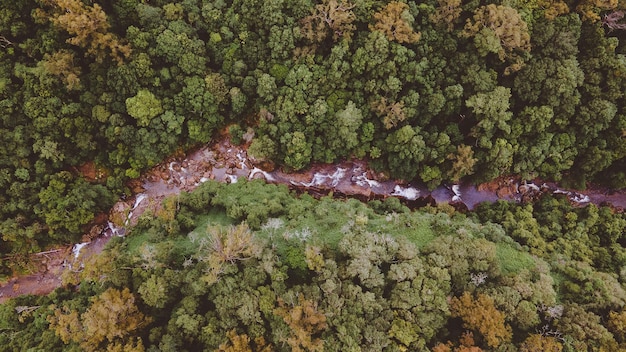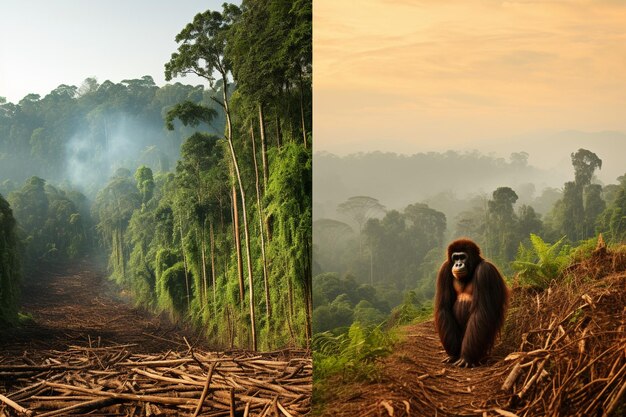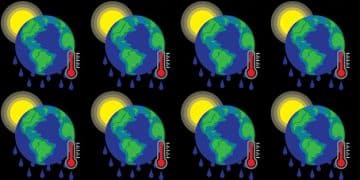Deforestation’s Impact: Amazon Biodiversity Loss and Global Effects

Deforestation drastically reduces biodiversity in the Amazon Rainforest, leading to species extinction, altered ecosystems, and significant global climate consequences due to decreased carbon sequestration and increased greenhouse gas emissions.
The alarming rate of deforestation, particularly in regions like the Amazon Rainforest, poses a grave threat to global biodiversity. The Impact of Deforestation on Biodiversity: A Case Study of the Amazon Rainforest and Its Global Consequences extends far beyond the loss of trees, triggering a cascade of ecological impacts with significant ramifications for the planet’s health and stability.
Understanding Deforestation and Its Drivers
Deforestation, the clearing of forests for other land uses, is a complex global issue with a myriad of intertwined drivers. Comprehending these factors is crucial to addressing the underlying causes of forest loss, particularly within sensitive ecosystems like the Amazon Rainforest.
Agricultural Expansion
One of the primary drivers of deforestation is the expansion of agricultural land. As the global population grows, so does the demand for food and resources, leading to the clearing of forests for crop cultivation and livestock grazing.
Logging Operations
Commercial logging operations, both legal and illegal, contribute significantly to deforestation rates. Selective logging, while seemingly less destructive, opens up the forest canopy, making it more vulnerable to further degradation and encroachment.
- Cattle ranching is a major driver in the Amazon, with vast areas cleared for pasture.
- Soybean cultivation for animal feed is expanding rapidly, encroaching on forested areas.
- Illegal logging practices often target valuable hardwood species, causing irreversible damage.
- Palm oil plantations in Southeast Asia contribute to widespread deforestation and habitat loss.
Addressing deforestation’s complex drivers requires a multifaceted approach involving sustainable land management practices, strengthened law enforcement, and global cooperation to reduce demand for products that contribute to forest loss. By understanding these drivers, we can develop targeted strategies to protect vital ecosystems and mitigate the devastating consequences of deforestation.

The Amazon Rainforest: A Biodiversity Hotspot in Crisis
The Amazon Rainforest, the world’s largest tropical rainforest, is an unparalleled reservoir of biodiversity. Its immense scale supports a staggering array of plant, animal, and insect species, many of which are found nowhere else on Earth. However, this vital ecosystem is facing an escalating crisis due to widespread deforestation.
The Uniqueness of Amazonian Biodiversity
The Amazon’s unique biodiversity is a result of its complex ecological history, favorable climate, and varied habitats. Its vastness allows for species diversification and specialization, creating intricate food webs and ecological relationships.
Deforestation Rates and Trends
Deforestation rates in the Amazon have fluctuated over the years, but recent trends show a concerning resurgence. Illegal logging, agricultural expansion, and mining activities are driving the destruction at an alarming pace.
- The Amazon is estimated to contain approximately 10% of the world’s known species.
- It plays a crucial role in regulating the Earth’s climate, absorbing vast amounts of carbon dioxide.
- Indigenous communities rely on the rainforest for their livelihoods, culture, and traditional knowledge.
- Deforestation not only destroys habitats but also disrupts vital ecosystem services like pollination and seed dispersal.
The Amazon Rainforest is a critical component of global biodiversity and climate stability. Its continued destruction has profound consequences for the planet, underscoring the urgent need for conservation efforts and sustainable development strategies. Protecting this invaluable ecosystem is essential for preserving its unique biodiversity and ensuring the well-being of future generations.
Impact on Plant Species and Ecosystems
Deforestation in the Amazon has a devastating impact on plant species and the intricate ecosystems they support. The loss of trees not only reduces the overall plant biodiversity but also disrupts vital ecological processes.
Loss of Plant Diversity
The Amazon is home to an estimated 40,000 plant species, many of which are endemic and have yet to be fully studied. Deforestation leads to the direct loss of these species, potentially before their unique properties and ecological roles are even understood.
Disruption of Ecological Processes
Forests play a crucial role in regulating water cycles, maintaining soil fertility, and providing habitat for pollinators and seed dispersers. Deforestation disrupts these processes, leading to soil erosion, decreased water availability, and reduced ecosystem resilience.

Plant species are the foundation of Amazonian ecosystems, providing food, shelter, and habitat for a wide range of animals and microorganisms. The loss of plant diversity weakens the entire ecosystem, making it more vulnerable to further disturbances and less able to recover from environmental changes.
Consequences for Animal Populations
The ramifications of deforestation extend far beyond the tree cover, significantly impacting the animal populations that call the Amazon home. As habitats shrink and disappear, animal species face increased threats to their survival.
Habitat Loss and Fragmentation
Deforestation directly leads to habitat loss, depriving animals of the food, shelter, and breeding grounds they need to survive. The fragmentation of forests isolates populations, reducing genetic diversity and increasing the risk of extinction.
Increased Human-Wildlife Conflict
As forests are cleared, animals are forced to venture into human-dominated landscapes in search of food and resources, leading to increased conflict with farmers and communities.
- Many iconic Amazonian species, such as jaguars, primates, and macaws, are threatened by habitat loss.
- Deforestation increases the risk of disease transmission between animals and humans.
- The loss of keystone species can trigger cascading effects throughout the ecosystem.
- Habitat fragmentation limits the ability of animals to migrate and adapt to changing environmental conditions.
Deforestation poses a significant threat to Amazonian animal populations, driving many species towards extinction. Protecting the rainforest is essential for safeguarding their future and maintaining the ecological integrity of this vital ecosystem.
Global Climate Impacts of Amazon Deforestation
The consequences of Amazon deforestation extend far beyond the immediate loss of biodiversity, exerting profound global climate impacts. The Amazon Rainforest plays a crucial role in regulating the Earth’s climate, and its destruction has far-reaching consequences for the planet.
Reduced Carbon Sequestration
Forests act as significant carbon sinks, absorbing carbon dioxide from the atmosphere and storing it in their biomass. Deforestation reduces the forest’s capacity to absorb carbon, contributing to the buildup of greenhouse gases.
Increased Greenhouse Gas Emissions
When forests are cleared, the stored carbon is released back into the atmosphere, primarily as carbon dioxide. Deforestation is a major source of greenhouse gas emissions, exacerbating climate change.
The Amazon Rainforest plays a critical role in regulating regional and global rainfall patterns. Deforestation disrupts these patterns, leading to decreased rainfall, prolonged droughts, and increased frequency of extreme weather events.
- Deforestation accounts for approximately 10% of global greenhouse gas emissions.
- The Amazon stores an estimated 80-120 billion tons of carbon.
- Deforestation can trigger positive feedback loops, accelerating climate change.
- The loss of the Amazon’s forests can have cascading effects on other ecosystems and human populations.
Amazon deforestation is a significant contributor to global climate change, with far-reaching consequences for the planet’s ecosystems and human societies. Protecting the Amazon Rainforest is essential for mitigating climate change and ensuring a sustainable future.
Conservation Efforts and Sustainable Solutions
Addressing deforestation and its impact on biodiversity requires a multifaceted approach involving conservation efforts and sustainable solutions. Protecting the Amazon Rainforest and other vital ecosystems is crucial for preserving biodiversity and mitigating climate change.
Protected Areas and Reforestation
Establishing and effectively managing protected areas is essential for safeguarding biodiversity hotspots and preventing further deforestation. Reforestation efforts can help restore degraded ecosystems and increase carbon sequestration.
Sustainable Land Management Practices
Promoting sustainable land management practices, such as agroforestry and reduced-impact logging, can help reduce deforestation rates and improve the livelihoods of local communities.
Empowering local communities to participate in conservation efforts is crucial for ensuring the long-term sustainability of these initiatives. Supporting indigenous rights and traditional knowledge can contribute to effective forest management.
- Implementing stricter regulations and enforcement mechanisms can help combat illegal logging and land clearing.
- Promoting ecotourism can provide economic incentives for conservation.
- Raising awareness about the impacts of deforestation can encourage consumers to make sustainable choices.
- Supporting research and innovation can lead to new approaches for forest conservation and restoration.
Conserving the Amazon Rainforest and other vital ecosystems requires a collaborative effort involving governments, organizations, communities, and individuals. By implementing sustainable solutions and supporting conservation initiatives, we can protect biodiversity, mitigate climate change, and ensure a sustainable future for all.
| Key Point | Brief Description |
|---|---|
| 🌳 Deforestation Drivers | Agricultural expansion, logging, and mining are key factors. |
| 🐒 Biodiversity Loss | Species extinction and habitat destruction are accelerating. |
| 🌍 Climate Impact | Reduced carbon sequestration and increased emissions contribute to global warming. |
| 🌱 Conservation Solutions | Protected areas, reforestation, and sustainable practices are crucial. |
[Frequently Asked Questions]
▼
Deforestation is the clearing of forests for other uses, driven by agriculture, logging, and mining. It occurs primarily to meet increasing global demands for land and resources.
▼
Deforestation leads to habitat loss and fragmentation, threatening countless species and disrupting ecological processes. Many endemic species face extinction risks due to decreased living spaces.
▼
Forests store vast amounts of carbon, and deforestation releases this into the atmosphere as carbon dioxide. This increases greenhouse gas concentrations, accelerating climate change.
▼
Conservation strategies include establishing protected areas, reforestation, and supporting sustainable practices. Strengthening law enforcement and empowering local communities are also vital.
▼
Individuals can support sustainable products, reduce meat consumption, and advocate for policies that protect forests. Raising awareness about the issue is another impactful way to help.
Conclusion
The impact of deforestation on biodiversity in the Amazon Rainforest presents a complex and urgent global challenge. Addressing the drivers of deforestation through sustainable solutions and robust conservation efforts is vital for preserving this critical ecosystem and mitigating its far-reaching consequences on the planet’s climate and biodiversity.





